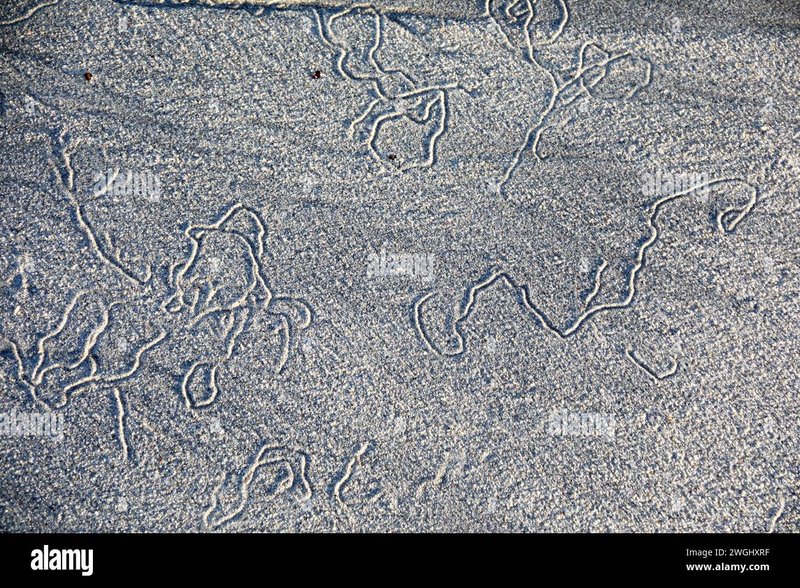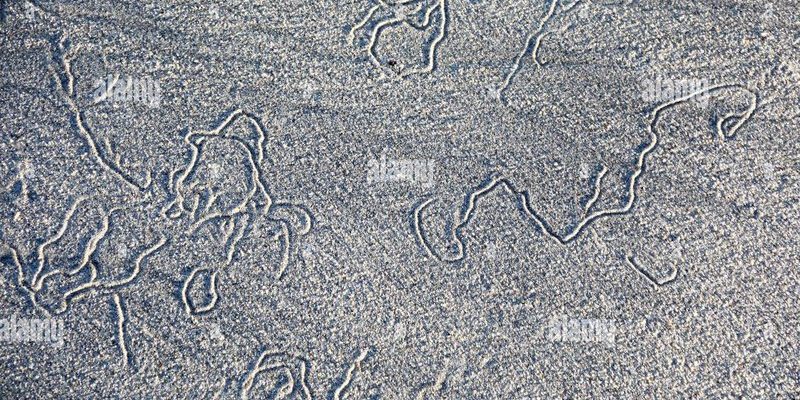
Bootlace worms, known scientifically as *Lineus longissimus*, have a unique way of navigating their environment. Though they’re mostly hidden beneath the surface, their trails can tell you a lot about what’s happening just out of sight. Identifying these trails can be a fun way to connect with nature and explore the ecosystem around us. So, let’s dive deep into identifying bootlace worm trails in wet sand and make sense of these natural wonders.
What Are Bootlace Worms?
Bootlace worms are remarkable creatures that can grow longer than a school bus—some individuals have been measured at over 30 meters! This may sound impossible, but these long, slender worms are quite real. Found mainly in shallow coastal waters, they often live in muddy or sandy substrates. Despite their size, they often go unnoticed because they spend most of their time hidden.
These worms are a type of marine annelid, which means they’re related to earthworms. Unlike your garden variety, bootlace worms have a strikingly different behavior. They can stretch and maneuver through sediments in an almost mesmerizing way, leaving behind trails that mark their journey. Have you ever seen a trail of ink left by a squid? It’s somewhat similar, but the bootlace worm’s trail is more like a delicate ribbon winding through the sand.
Knowing a bit about these worms helps when we try to identify their trails. The next time you see those squiggly lines, you’ll have a better appreciation of what’s happening under the sand!
Recognizing Bootlace Worm Trails
Identifying bootlace worm trails is like being a detective on the beach. Their trails are usually long, thin, and winding, almost resembling a series of loops or squiggles. Here’s what to look for:
- Length: Bootlace worm trails can be quite long, sometimes stretching several meters across the wet sand. They don’t usually form small, tight patterns but rather elongated, flowing curves that can take you on a winding journey.
- Width: The trails are generally thin, often just a few centimeters wide. This narrowness can set them apart from tracks made by other animals, like crabs, which tend to leave wider imprints.
- Depth: If you look closely, you’ll notice these trails are often slightly indented into the sand. This is because the bootlace worm burrows through the sand as it moves, leaving a slight impression.
If you see a combination of these features, you’re likely looking at a bootlace worm trail. But it’s not just about recognizing what you see; it’s also about the context. These trails are usually found in wet, sandy areas, typically where the tide has recently receded.
How Bootlace Worms Create Their Trails
You might be wondering how these long worms manage to create such intricate patterns as they glide through the sand. The answer lies in their unique motion and behavior.
Bootlace worms move by contracting and stretching their bodies, much like a slinky toy. As they inch forward, they push through the sediment, leaving behind a trail of displaced sand. This motion is similar to how a snake slithers across the ground. The worm’s body is made up of segments, and as one segment contracts, the next one stretches, allowing for this fluid movement.
Also, bootlace worms are known to produce a slimy mucus as they travel. This mucus can help them navigate through tight spots in the sand while also aiding in their locomotion. You can think of it as a lubricant, allowing them to slide easily through their environment without getting stuck. The combination of their movement and this slimy trail is what makes spotting their paths both interesting and beautiful.
Common Misidentifications
When you’re scanning the shores for bootlace worm trails, it’s easy to accidentally mix them up with other types of animal tracks. Here are a couple of common misidentifications to watch out for:
- Crab Tracks: Crabs often leave behind tracks that can look similar but usually include more irregular shapes with wider impressions. They generally have a more chaotic and jagged appearance compared to the smooth, flowing lines of bootlace worm trails.
- Fish Scales: Sometimes, you might find shiny, scale-like remnants in the sand. While these can be fascinating, they are usually just remnants of fish or other sea creatures, not trails. Bootlace worm trails have a more continuous pattern and a specific shape that set them apart.
Being aware of these common misidentifications can enhance your observation skills. By knowing what to look for, you can become more confident in spotting those elusive bootlace worm trails.
Why Observing Worm Trails Matters
You might be wondering why it’s important to identify bootlace worm trails in the first place. Understanding these natural occurrences can give us insight into the health of coastal ecosystems. Here are a few reasons why you should pay attention to them:
1. Ecosystem Health: Bootlace worms play a role in the ocean’s food chain. By studying their trails, researchers can observe which areas are healthy habitats for marine life. This information can be crucial for conservation efforts.
2. Biodiversity Indicators: The presence of bootlace worms can indicate a diverse ecosystem. If trails are abundant in a particular area, it might suggest a well-balanced environment where various species can thrive.
3. Scientific Research: Studying these trails helps scientists learn about marine behavior and sediment dynamics. Each trail tells a story of movement, feeding habits, and population dynamics. By gathering data, researchers can better understand marine ecosystems and develop effective strategies for their preservation.
Recognizing the significance of bootlace worm trails can deepen your appreciation for the ocean and all its inhabitants. Each squiggly line you see might be revealing a part of the bigger picture.
Next time you find yourself by the shore, take a moment to observe those fascinating trails in the sand. Bootlace worms and their intricate movements remind us just how interconnected our ecosystems are. By learning to identify their trails, you’re not just looking at a simple mark in the sand—you’re engaging with a rich, thriving environment that holds many secrets.
So, grab your friends or family and head out to the beach. Keep an eye out for those squiggly lines, and celebrate the wonders of nature right beneath your feet. It’s incredible to think about the life hidden away as you explore the shoreline, leaving no stone unturned. Happy beachcombing!

